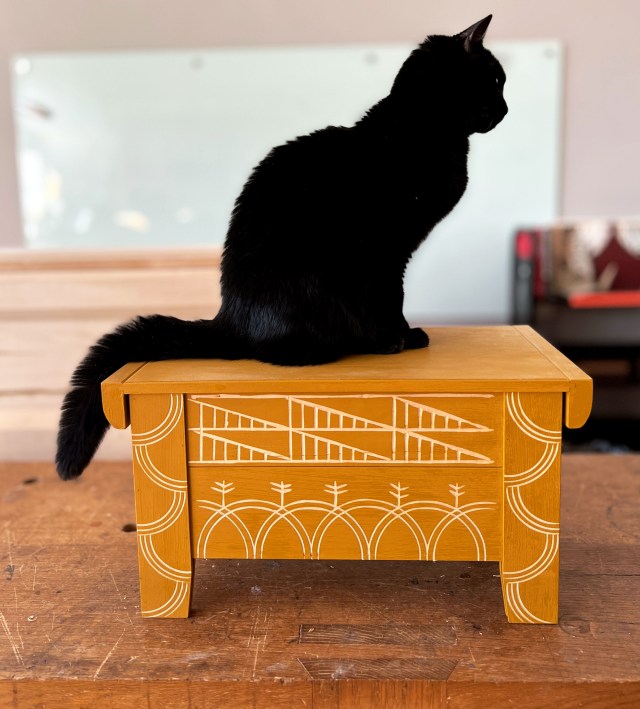
The following is excerpted from “The Belligerent Finisher,” by John Porritt. After walking you step by step through creating a believable aged finish, the book includes a gallery of just some of John’s gorgeous work.

I think the phrase “standing on the shoulders of giants” has the ring of truth, certainly in woodworking. That, and the idiosyncratic nature of many vernacular woodworkers, plus the vagaries of time, have inspired me to try to understand some of the mystery of the old stick chairs. To work with that, simulate it (or “stimulate” as my old friend Johnny Jones would have said) and then, on occasion – having fallen short – sitting down in an odd chair with a restorative cup of tea, to ponder having another go. That’s my form of belligerence, and these are some of my chairs.


My first Welsh-inspired stick chair, made circa 1994 in Shropshire, England. I sent photos of several English and American-influenced chairs along with one of this chair – which draws on what at the time I thought of as a Welsh stick chair – to John Brown. He kindly wrote back to me and for a while we had a correspondence. He went so far as to speak highly of the chair and published a photo in Good Woodworking magazine. Looking back I now feel this chair is an amalgam of John Brown’s work with the steam-bent arm and an American way of shaping the hands, along with an exaggerated Welsh comb. It was my jumping-off point as I started to look more carefully at what the old Welsh chairmakers, in all their diversity, had achieved.
The chair has lived in Shropshire ever since and is a well-used and appreciated member of a friend’s family. It has an elm seat and steam-bent ash arm-bow, with ash legs, sticks and comb. The green paint was my first attempt at making a milk paint. It was not waxed and has had no intentional distressing other than the normal wear and tear of family life. It’s doing well.


This commissioned chair was an adventure. I found a curved ash branch, so I was able to make my first two-part scarfed and wedged armbow. The chair has a piece of oak with character for the seat, 10 ash sticks and an ash comb, legs and stretchers. The naturally curved ash arm supports have that gnarly grain that seems to encapsulate the life of a small tree in a harsh environment. The wood was never aged. It was painted with Lexington green milk paint, with a little added black, then waxed. Nearly 20 years later, every-thing has mellowed to a pleasing warmth with that dry bloom look some of the old chairs have. I once heard an elderly antique furniture dealer describe this look as “sleepy.” It was a pleasure to exhibit this chair at Westonbirt, The National Arboretum in Gloucestershire in “Chairs 2004.”


This, and the following chairs, were made in Spencertown, N.Y. The seat of this chair is English-grown burr oak from Picklescott, Shropshire. Ash sticks, legs and comb. Three-part arm in hard maple. Side stretchers and two arm posts in white oak, center stretcher hickory.
Finished with boiled linseed oil, no wax involved. I left the seat unfinished, owing to burr wood taking up the linseed oil quite aggressively in parts. It’s coloring down well with time. It’s my daughter’s favorite chair.


This and the two previous chairs are known as “lobster pot” chairs. Linseed oil and wax finish. English elm seat with ash throughout, scarfed and wedged armbow. Neither this chair nor the previous one had any wood-aging treatment. After several years, the color is getting good and mellow.


This chair, made at the start of the COVID-19 pandemic, was a major step for me down the road of getting the feeling I needed into a chair. It’s the only chair I have ever pictured completely in my head, then built and finished. It seemed to flow through me. Most chairs are a journey from armbow to what is possible, and I will work through various cul-de-sacs and hiccups along the way. Not this one.
The finishing process on this chair was similar to that described in chapter one. This one was finished with homemade black milk paint. American white elm seat (extremely difficult to work – much belligerence needed). Scarfed and wedged ash armbow. This was my first North Wales four-stick-inspired chair. It owes a lot to the chair on the over of John Brown’s great book, “Welsh Stick Chairs.” I consider this to be the most important chair I’ve ever made, certainly in my understanding and development.


Inspired by a chair from the wonderful book “The Welsh Stick Chair” by Tim and Betsan Bowen. Finished using nitric acid, Lexington green milk paint with a little added black, shellac, cement dust, linseed oil and 10-percent roofing cement with wax. The scarfed arms are in black birch – a great wood to work and color. They were eventually burnished with heavy brown paper after the chainmail burnisher and antler. White oak seat, American white elm comb; red oak legs, stretchers and sticks.


My first attempt at working a chair in red. Before painting, I used nitric acid, then Salem red paint, most of which I took right back off, scrubbing with coarse and medium 3M pads with thinners. After that, I painted it over with one coat of a mixture of red, brown and black milk paint. Shellac, cement dust, linseed oil, 10-percent roofing cement and wax completed the process. English elm seat, black birch two-part armbow, white oak comb. The legs, stretchers and sticks are red oak.


Soft maple two-part seat, cross-tenoned and pegged with scarfed hickory arms and sticks, oak comb, ash arm supports, legs and stretchers. Finished using nitric acid, a workshop-mixed thin brown milk paint, then shellac, cement dust, linseed oil and wax, with 10-percent roofing cement. I enjoy its stolid, “I’m here. That alright with you?” stance.


Another version of a North Wales four-stick chair. This exceedingly comfortable chair was left in the paint and waxed to allow Tom, its owner, to perform DIY chair distressing, at least three times a day. Oh yes, and let’s not forget the tea breaks. American white elm two-part seat, cross-tenoned and pegged, scarfed black birch armbow, hickory sticks and legs with an ash comb.


I really enjoy the visual movement of this chair. It is entirely made of white oak, apart from the scarfed and pegged arms of ash. The chair was fumed for 72 hours with ammonia then (minus the use of vinegar iron and brown mahogany oil stain) it was worked in a similar fashion to the green chair, Backstool No. 2 in chapter two. I did over-paint a lot of the Lily Pad green to get that crusty look, which I later distressed with the chainmail burnisher.
Apart from being stung by a tiny wasp while foraging by the roadside – where I managed to find an excellent piece of white oak for the comb – this chair came together happily.


Another very comfortable red chair. The photo of the entire chair was taken right after it was made; the two detail shots are after several months of use.
Note how the workshop-mixed milk-paint surface of mulberry is chipping with use to let the thick flag-red milk paint come through. Not introduced wear. I have enjoyed watching this evolve. Better than watching paint dry. White oak seat, legs, stretchers and comb, hickory sticks, ash armbow and doubler.


Over the years, I’ve made quite a few child’s chairs. To my eye, this one works well for proportion. The paint is Lily Pad green with a coat of Lexington green over the top, cut back to let the Lily Pad come through on the seat. The wear-through to the wood on the seat front, and slight wear all around, is my suggestion of rough-and-tumble in a nursery. Soft maple cross-tenoned and pegged seat, black birch two-part scarfed and pegged arm, ash legs, stretchers and sticks. Two outer sticks red oak.


I spent a long time attempting to get the white oak seat, hickory sticks, and ash arms and doubler, legs, stretchers and comb to a satisfactory surface. It didn’t work. So, over the entire chair (bar the arms) I painted Arabian Night black milk paint. Things don’t always work out – I think I was pushing too hard for an effect the chair didn’t need. I think this chair, which has a busy appearance, looks better for its unity of surface. This might be considered a fall-back position, but it is one I’m happy with. How much belligerence can one chair take? How much tea can one man drink?















